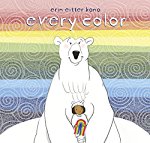Many of us, when we juggle bills, contemplate a car that needs replacing, work in a job that is often tedious or boring, imagine what it would be like if we could turn what we love doing into a career that would bring us fame and fortune. How grand it would be to be a master gardener who wins huge prizes, or a virtuoso musician who plays in concert halls all over the world. We assume that 'success' will bring us happiness, but what if success and happiness do not necessarily go together?
 The bear and the piano
The bear and the piano
 The bear and the piano
The bear and the piano
David Litchfield
Picture Book
For ages 5 to 7
Clarion Books, 2016, 978-0-544-67454-7
One day a young bear cub finds a strange object standing
in a clearing in the forest. It is made of wood and there are black and white
keys running down the length of it. The cub touches the keys with his paws and makes
a dreadful sound. The little bear leaves, but he comes back the next day, and
the next.
For weeks,
months, and years the bear comes to tap the black and white keys every day. By
the time he is a grown up grizzly, the bear can make beautiful music when he
plays the piano, for that is what the object in the forest is.
The bear’s
playing attracts the attention of the other bears in the forest, who all come
to the clearing every night to listen to him play. Then a father and daughter
hear the bear play and they invite him to go to the city with them where he
will be able to play pianos for “hundreds of people and hear sounds so
beautiful they will make your fur stand on end.”
The bear goes to
the city and it isn’t long before he is the toast of the town. Everyone wants to
hear him play, and his concerts are sold out. He records albums, wins awards,
and is feted by everyone he meets.
Though he is a
great success in the city, the bear could not help feeling, deep inside, that
something is missing in his life.
This beautiful
book, with its gorgeous atmospheric artwork, takes a look at what can happen
when you seek out fame and fortune. If you are a successful celebrity does this
mean that you have everything you need to be happy? Or is there is something
more precious than wealth, recognition, and success?








